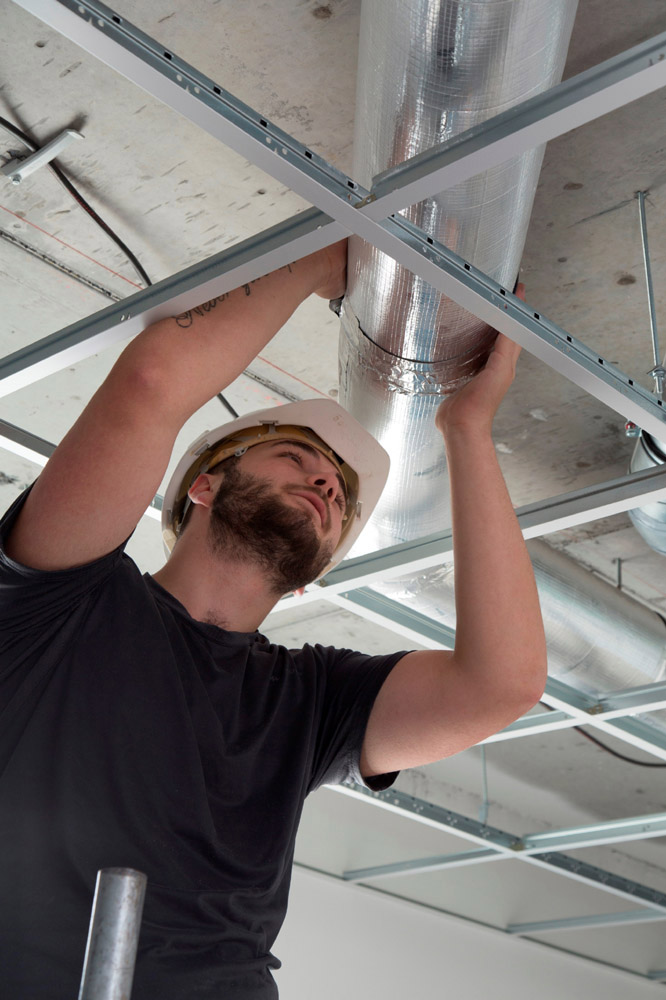
Martyn Brown, Technical & Contracts Manager at Triton Showers, explains the step-by-step process of installing two Instaflow Stored Hot Water Heaters
Mackart Additive is a Rugeley-based firm that specialises in the design and production of components using the additive layer process. A key issue facing the business was that an existing 10L hot water storage system that was pre-installed on their premises was struggling to cope with demand.
With hot water regularly required to rinse and clean additive manufactured parts and components, Steven McCarthy, Managing Director and Principal Technical engineer at Mackart, decided to approach Triton Showers to help design a solution that could address the business’s needs.
Following a consultation with Martyn Brown, Contracts and Technical Manager at Triton, it was decided that opting for a pair of 15L Instaflow unvented stored water heaters in place of the single, smaller unit would help solve Mackart’s problems.
The Instaflow’s compact size means the product is easy to install, resulting in little downtime for the customer. It is designed for under-sink situations or can be tucked away in a discreet location. With easy to operate controls, it gives quick heat up times with variable temperature settings to a maximum of 75°C. Here is a step-by-step on how the installation at Mackart was achieved.
Disconnect power and water supply and check components
Unbox the Instaflow Stored Hot Water Heater and check that all components have been supplied.
When installing into an existing plumbing system, it is vital that both the water and electric supply is switched off before starting work.
Removing the old unit and siting new brackets
Mackart’s existing 10L stored hot water heater was removed and new supports to hold the Instaflow Stored Hot Water Heaters were installed.
The Instaflow is pre-supplied with a wall mounting bracket – use this as a guide to mark the fixing holes to the wall.
Insert O-Rings into cold water inlet and hot water outlet
The Instaflow has a cold water inlet and a hot water outlet. Before attaching the components to the unit, ensure that the O rings are inserted to prevent leaks. The unit can then be mounted onto the wall bracket.
Connecting the pipework
Once the unit has been mounted, it is simply a case of connecting pipework up to the unit. In Mackart’s case, one mains cold feed serves both Instaflow Stored Hot Water Heaters.
If using copper compression fittings, ensure that all connections are adequately tightened to prevent leakages.
Commissioning and testing water temperature
Following the installation of pipework, the Instaflow Stored Hot Water System can be commissioned. After commissioning, the water temperature needs checking to ensure everything is working correctly.
This procedure must be completed with the electricity switched off at the isolating switch.
Fully open the outlet tap and allow the water heater to fill until a smooth flow is obtained; allow time for air and any debris to be flushed from the unit. Once flushing out has been completed, stop the water by turning off the outlet tap. Plug the heater in and switch on the electricity supply and it is now ready for normal use.
Check that the water is at the desired temperature by placing a digital temperature thermometer under running water from the unit.
Lagging the pipework
For safety purposes and to prevent water from freezing in the pipework, lagging the cold water pipes is recommended as a final step.
Following the installation, Steven McCarthy, Managing Director and Principal Technical Engineer at Mackart Engineering, said: “Ease of fit is one of the big advantages of Triton’s Instaflow. Our premises didn’t have to have any special provisions made, which was a huge plus point. Our old heater was simply removed and the Instaflow units plumbed into the current pipework.
“The whole process of decommissioning our old appliance and commissioning the new Instaflow units took less than a day and caused minimal disruption. As a result of the changeover, we now have a sufficient supply of hot water available when we need it – for everything from cleaning parts to washing hands.”
Installing stored hot water heaters involves dealing with both water and power supplies. Work should only be carried out by someone who is Part P qualified, meaning they are certified to work with both plumbing and electrics. Triton’s Instaflow Stored Hot Water Heater comes in three sizes, able to store either 5, 10 or 15 litres of hot water. It has a corrosion resistant, enamel coated heater tank that is not only durable but will blend seamlessly into any commercial environment.
For more information on Triton’s Instaflow Stored Hot Water Heater visit
https://www.tritonshowers.co.uk/instaflow-stored-water-heater







